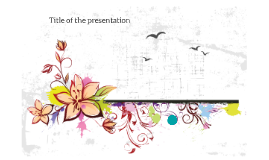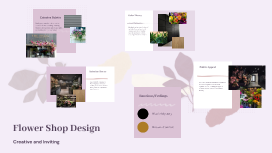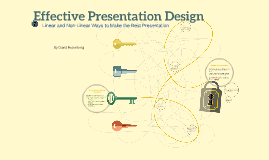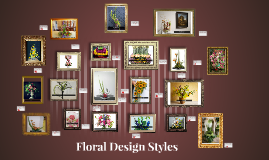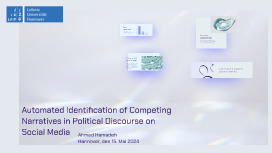Flower Design Styles
Transcript: • A term originating in Europe for a composition of relatively few, well-organized materials, usually placed in groups, emphasizing bold forms and clean lines. Generous use of negative space accentuates the individual flowers, leave, stem angles, colors and textures. Radial stem placement and asymmetrical balance are typical. This type of design is sometimes referred to as high styles • A classical, massed composition evocative of the traditionally lush Herbaceous Borders of England. Popularized by the 20th-century gardeners and designers such as Gertrude Jekyll and Constance Spry, English garden designs feature an abundance of seasonally compatible, radially arranged plant materials in a profusion of forms and colors. The inclusion of woody stem branches and foliage is typical, frequently being used to express the gracefully arching lines that are characteristic for the style. These designs have served as the inspiration for the classically styled flower arrangements of the southern United States. Sweet Pea-Lathyrus Snapdragon-Antirrhinum Lisianthus-Eustoma Chrysanthemum-Chrysanthemum Complimentary-yellow, purple Tulip-Tulipa Aster-Aster Snapdragon-Antirrhinum Gerber Daisy-Gerbera Solidago-Solidago Flat Fern-Polystichum African Lily-Agapanthus Chrysanthemum-Chrysanthemum Yarrow-Achillea Sunflower-Helianthus Dill-Anethum Solidago-Solidago Israeli Ruscus-Ruscus Chrysanthemum-Chrysanthemum Speedwell-Veronica Gladiola-Gladiolus Hydrangea-Hydrangea Swiss Cheese Plant-Monstera Philodendron-Philodendron Papyrus-Cyperus Hogarth Curve Bear Grass-Xerophyllum Oriental Lily-Lilium Hala Leaf-Pandanus Dichromatic-pink and blue Calla Lily-Zantedeschia Curly Willow-salix Rose-Rosa Sunflower-Helianthus Wheat-Triticum Oriental Lily-Lilium Spray Rose-Rosa https://www.pinterest.com/acano0829/dried-flower-arrangements/ Dichromatic-yellow and green • A rounded or conical floral arrangement, similar to a nosegay, named for a German style of interior design of the early 1800s. a biedermeier design is typically created with compact spiraling or concentric circles, each featuring a particular flower or color, with virtually no negative space Monochromatic-Orange https://www.pinterest.com/alisonchestnutt/flowers/ Western Line Design • A general term for symmetrical and asymmetrical triangle, L-shaped, Horizontal, vertical, crescent, and pointed-oval arrangements, which are based on geometric forms. These arrangements are characterized by a well-established focal area near the lip of the container. All stems appear to radiate from this base. The height is typically at least one and one half to two times the height or width of the container, whichever is greater. The western line style is derived from the linearity of Ikebana combined with the traditional massed arrangements of Europe, giving rise to the term Line Mass design. • A type of circular shelter design resembling a bird’s nest. Several layers of plant materials encircle the center to create a feeling of protection, and at the same time draw the eye inward. A composition in which the floral materials are completely enclosed inside a vessel, such as a glass vase. A composition in which parts of the arrangement are “protected” by a structure of branches or other materials that extend over and above it. Less commonly, a design created deep inside a container in which the walls and or rim of the vessel itself “protect” the design https://www.pinterest.com/camillalyle/sunflower-weddings/ • A composition of fresh cut, dried, or artificial plant materials assembled into the form of a garden topiary, typically a standard Enclosure/Shelter Analogous-red, orange, purple http://www.wsj.com/articles/a-bouquet-inspired-by-a-richard-diebenkorn-painting-1410971260 Achromatic-white Dichromatic-Pink and purple https://www.pinterest.com/katiedavenpotty/victorian-misc/ Pussy Willow-Salix Carnation-Dianthus Leather Leaf-Rumohra Alder Twig-Alnus Dracaena-Dracaena Colonial • An arrangement that features descending lines of plant materials in the manner of falling water. Descending lines, sometimes intentionally crossed, and several layers of different, typically sheer materials with delicate textures emphasize depth and create a flowing effect. Non floral and/ or reflective elements are often incorporated. The mechanics may be foam-based or hand-tied Abstract https://acroquet.wordpress.com/2012/04/16/landscape-vs-vegetative-arrangements/ • A three-dimensional, closed form composition consisting of a clearly defined geometric shape that is wholly or partially filled or outlined with plant material and or decorative accents. None of the materials used should violate the integrity of the geometric form: cone, pyramid, obelisk, sphere Stacked/Hedgerow Vegetative Volumetric monochromatic-pink • Grouping large masses of flowers, foliage, and grasses together to create a compact design with few voids and no obvious center of interest. Usually these arrangements were round or oval in shape. Flower on







